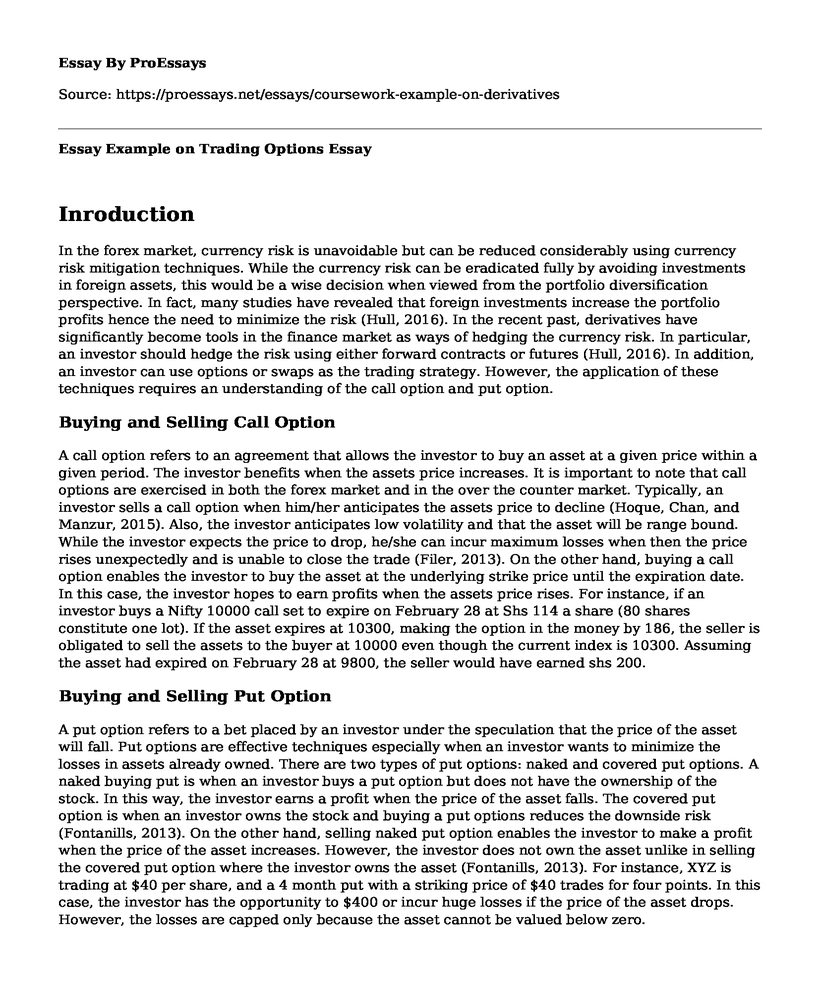Inroduction
In the forex market, currency risk is unavoidable but can be reduced considerably using currency risk mitigation techniques. While the currency risk can be eradicated fully by avoiding investments in foreign assets, this would be a wise decision when viewed from the portfolio diversification perspective. In fact, many studies have revealed that foreign investments increase the portfolio profits hence the need to minimize the risk (Hull, 2016). In the recent past, derivatives have significantly become tools in the finance market as ways of hedging the currency risk. In particular, an investor should hedge the risk using either forward contracts or futures (Hull, 2016). In addition, an investor can use options or swaps as the trading strategy. However, the application of these techniques requires an understanding of the call option and put option.
Buying and Selling Call Option
A call option refers to an agreement that allows the investor to buy an asset at a given price within a given period. The investor benefits when the assets price increases. It is important to note that call options are exercised in both the forex market and in the over the counter market. Typically, an investor sells a call option when him/her anticipates the assets price to decline (Hoque, Chan, and Manzur, 2015). Also, the investor anticipates low volatility and that the asset will be range bound. While the investor expects the price to drop, he/she can incur maximum losses when then the price rises unexpectedly and is unable to close the trade (Filer, 2013). On the other hand, buying a call option enables the investor to buy the asset at the underlying strike price until the expiration date. In this case, the investor hopes to earn profits when the assets price rises. For instance, if an investor buys a Nifty 10000 call set to expire on February 28 at Shs 114 a share (80 shares constitute one lot). If the asset expires at 10300, making the option in the money by 186, the seller is obligated to sell the assets to the buyer at 10000 even though the current index is 10300. Assuming the asset had expired on February 28 at 9800, the seller would have earned shs 200.
Buying and Selling Put Option
A put option refers to a bet placed by an investor under the speculation that the price of the asset will fall. Put options are effective techniques especially when an investor wants to minimize the losses in assets already owned. There are two types of put options: naked and covered put options. A naked buying put is when an investor buys a put option but does not have the ownership of the stock. In this way, the investor earns a profit when the price of the asset falls. The covered put option is when an investor owns the stock and buying a put options reduces the downside risk (Fontanills, 2013). On the other hand, selling naked put option enables the investor to make a profit when the price of the asset increases. However, the investor does not own the asset unlike in selling the covered put option where the investor owns the asset (Fontanills, 2013). For instance, XYZ is trading at $40 per share, and a 4 month put with a striking price of $40 trades for four points. In this case, the investor has the opportunity to $400 or incur huge losses if the price of the asset drops. However, the losses are capped only because the asset cannot be valued below zero.
Bid Offer
Spot 0.2 0.203
6 months 0.203 0.210
Suppose the exchange rates are shown in the table above. In six months, Mr. Curtis will buy 100000 JPY; therefore, he should hedge against exchange risks. Using the quotes in the table above, he can agree to buy 100000 JPY at an exchange rate of 0.210. In this regard, he will have a long forward contract on JPY because he has agreed to buy 100000 from the bank for $22100. Thus, the bank has a short forward contract on JPY because it has agreed to sell $22100 for 100000JPY.
References
Filer, H. (2013). Understanding put and call options: How to use them to reduce risk in your stock market operations. Mansfield Centre, CT : Martino Publishing
Fontanills, G. A. (2013). Trading options for dummies. Hoboken, N.J: John Wiley & Sons.
Hoque, A., Chan, F., & Manzur, M. (2015). Modeling Volatility in Foreign Currency Option Pricing. Multinational Finance Journal, 13(3/4), 189-208. http://dx.doi.org/10.17578/13-3/4-2
Hull, J. C., & Basu, S. (2016). Options, futures, and other derivatives. Pearson Education India.
Cite this page
Essay Example on Trading Options. (2021, Sep 01). Retrieved from https://proessays.net/essays/coursework-example-on-derivatives
If you are the original author of this essay and no longer wish to have it published on the ProEssays website, please click below to request its removal:
- Isabella Bank Financial Analysis Paper Example
- Essay Sample on PNC Bank
- The Great Recession 2007- 2009 Essay Example
- 46% College Graduates Reap Benefits of Higher Earning and Debt - Research Paper
- Performance Management & Appraisal: Aligning Performance With Objectives - Essay Sample
- Employee of the Month: A Moment of Pride and Appreciation - Essay Sample
- Essay on Healthy Eating on a Budget: Peanut Butter, Unsalted Pepitas & Flax Seeds







